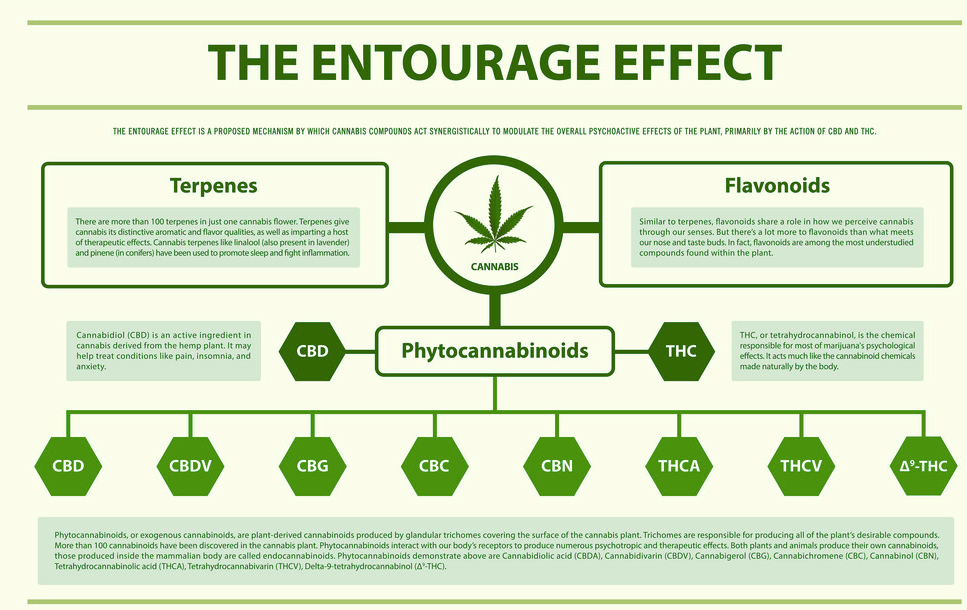
The Entourage Effect: THCa’s Synergistic Interactions with Other Cannabinoids
Definition of the Entourage Effect
The entourage effect refers to the synergistic interactions between different compounds found in the cannabis plant, particularly the beneficial effects of the combination of tetrahydrocannabinolic acid (THCA) with other cannabinoids.

While THCa is a non-psychoactive compound found in raw cannabis, it is known to have therapeutic potential due to its ability to interact with the body’s endocannabinoid system. The entourage effect suggests that when THCA is combined with other cannabinoids, such as THC and CBD, the overall therapeutic benefits are enhanced.
This phenomenon has been studied extensively in recent years, with researchers exploring the mechanisms of action and potential for therapeutic benefits in various clinical conditions.
Understanding the entourage effect may lead to the development of more effective treatments and optimize the therapeutic potential of the cannabis plant.
History of the Entourage Effect
The history of the Entourage Effect can be traced back to pioneering research conducted by Raphael Mechoulam in the field of cannabis. Mechoulam, a renowned Israeli chemist, is credited with the discovery of individual cannabinoids and their properties, which laid the foundation for understanding the therapeutic potential of cannabis.
In the 1960s, Mechoulam and his team identified and isolated delta-9-tetrahydrocannabinol (THC), the main psychoactive component of cannabis. This groundbreaking discovery led to further investigations into other cannabinoids, such as cannabidiol (CBD). Mechoulam’s work paved the way for studying the effects of cannabinoids on the human body.
The concept of the Entourage Effect emerged as researchers began to recognize that the beneficial effects of cannabis could not be attributed solely to THC or CBD alone. Rather, the combined interaction of multiple cannabinoids, as well as aromatic compounds and other plant extracts, was found to have a synergistic effect.
Understanding the Entourage Effect is crucial for unlocking the full potential of cannabis as a therapeutic agent. Numerous studies have shown that the combined action of cannabinoids can enhance their therapeutic benefits, such as the ability to reduce inflammation, relieve pain, and modulate neurotransmitter activity.
The history of the Entourage Effect can be traced back to Raphael Mechoulam’s groundbreaking research on individual cannabinoids. Recognizing the synergistic interactions of these compounds is key in harnessing the therapeutic potential of cannabis.
The Role of THCa in the Entourage Effect
THCa (tetrahydrocannabinolic acid) plays a crucial role in the entourage effect, which refers to the synergistic interactions between various cannabinoids found in the cannabis plant. As the acidic precursor to THC, THCa has distinct properties that contribute to the therapeutic effects of cannabis.
THCa interacts with other cannabinoids, such as CBD and CBG, to enhance their therapeutic potential. Studies have shown that the combination of these cannabinoids can have a greater therapeutic effect than when used individually. This synergy is believed to be due to THCa’s ability to modulate different signaling pathways in the body.
One way in which THCa contributes to the entourage effect is through its interaction with the endocannabinoid system. THCa can bind to CB1 and CB2 receptors, which are part of this system, and influence their activity. This modulation of cannabinoid receptor activity may contribute to the overall therapeutic effects of cannabis.
Additionally, THCa has been found to have anti-inflammatory properties, which can further enhance its therapeutic potential. By targeting multiple pathways involved in inflammation, THCa can help reduce inflammation and alleviate associated symptoms.
Overall, THCa’s synergistic interactions with other cannabinoids play a crucial role in the entourage effect and contribute to the therapeutic effects of cannabis. Further research is needed to fully understand the specific mechanisms by which THCa and other cannabinoids interact and how they can be utilized for optimal therapeutic benefits.
Mechanism of Action
The entourage effect occurs when THCa interacts with other cannabinoids in the cannabis plant, such as CBD and CBG, to produce enhanced therapeutic effects.
THCa’s mechanism of action involves its ability to modulate different signaling pathways in the body. It can bind to CB1 and CB2 receptors, which are part of the endocannabinoid system, and influence their activity. This modulation of cannabinoid receptor activity is believed to contribute to the overall therapeutic effects of cannabis.
Additionally, THCa has been found to have anti-inflammatory properties, targeting multiple pathways involved in inflammation. By reducing inflammation, THCa can provide further therapeutic potential. Understanding the mechanism of action of THCa and its interactions with other cannabinoids is crucial in unlocking the full therapeutic benefits of cannabis.
Future studies exploring the entourage effect can potentially lead to the development of new treatment options for various conditions.
Cannabinoid Receptors and Signaling Pathways
Cannabinoid receptors play a crucial role in the entourage effect, which refers to the synergistic interactions between different cannabinoids found in the cannabis plant. There are two main types of cannabinoid receptors: CB1 and CB2.
CB1 receptors are primarily found in the central nervous system and are responsible for the psychoactive effects of cannabinoids like THC. They are also present in other tissues, such as the liver, adipose tissue, and reproductive organs. CB1 receptors participate in various signaling pathways that regulate neurotransmitter release, resulting in effects like pain relief, relaxation, and alleviation of anxiety.
On the other hand, CB2 receptors are mainly located in immune cells and peripheral tissues. They play a vital role in modulating inflammation and immune responses. Activation of CB2 receptors can lead to therapeutic effects such as reducing pain and inflammation, and enhancing immune function.
When different cannabinoids, such as THC, CBD, or THCA, interact with these receptors, they can have differential effects. For example, THCA has been found to have anti-inflammatory and neuroprotective properties. Its interaction with CB1 and CB2 receptors, as well as other receptors like the 5-HT1A receptor, contribute to its therapeutic potential.
The signaling pathways activated by cannabinoid receptors involve G-proteins, phospholipase C, and cyclic AMP. These pathways trigger various cellular responses, including the modulation of neurotransmitters, cytokines, and inflammatory mediators.
The entourage effect is rooted in the idea that these receptors and signaling pathways work together to produce the beneficial effects of different cannabinoids. Future studies will shed more light on the mechanisms of action and clinical potential of these interactions.
Interactions between Cannabinoids, Terpenes, and Flavonoids
The entourage effect refers to the synergistic interactions between cannabinoids, terpenes, and flavonoids found in the cannabis plant. When these compounds work together, they can enhance the therapeutic effects of cannabis and potentially create synergistic effects.
Cannabinoids, such as THC and CBD, have been extensively studied for their individual therapeutic benefits. However, research suggests that when combined with other compounds, such as terpenes and flavonoids, their effects can be amplified.
Terpenes are aromatic compounds found in many plants, including cannabis. They contribute to the distinct flavors and aromas of different cannabis strains. Terpenes can also interact with cannabinoid receptors and other receptors in the body, potentially enhancing the effects of cannabinoids. For example, the terpene beta-caryophyllene has been found to have anti-inflammatory properties and can selectively activate the CB2 receptor.
Flavonoids, another group of compounds found in cannabis, have also shown potential therapeutic benefits. They have antioxidant and anti-inflammatory properties and may contribute to the overall entourage effect.
The specific combination of cannabinoids, terpenes, and flavonoids in a cannabis strain may have unique effects for certain health conditions. For example, a combination of THC, CBD, and the terpene myrcene has been found to have potential sedative effects, which may be beneficial for patients with insomnia or anxiety.
The interactions between cannabinoids, terpenes, and flavonoids are believed to create the entourage effect, enhancing the therapeutic effects of cannabis. Further research is needed to fully understand these interactions and their potential benefits for various health conditions.
5-HT1A Receptors and Serotonin Signaling Pathways
The entourage effect refers to the synergistic interactions between different compounds in the cannabis plant, including cannabinoids, terpenes, and flavonoids. When it comes to THCa, the acidic precursor to THC, one important mechanism of action involves its interaction with 5-HT1A receptors and the serotonin signaling pathway.
5-HT1A receptors are a subtype of serotonin receptors located in the brain and other tissues. Serotonin is a neurotransmitter involved in regulating various physiological processes, including mood, anxiety, appetite, and sleep. Activation of 5-HT1A receptors has been implicated in producing anxiolytic, antidepressant, and antiemetic effects.
THCa has been shown to bind to and activate 5-HT1A receptors, modulating serotonin signaling and potentially contributing to its therapeutic effects. By interacting with these receptors and the serotonin signaling pathway, THCa may exert anxiolytic and antidepressant effects, alleviate nausea and vomiting, and improve cognitive function.
Furthermore, 5-HT1A receptor agonists, including THCa, have been studied for their potential therapeutic benefits in conditions such as anxiety, depression, nausea, and cognitive impairment. Although further research is needed to fully understand the mechanisms and clinical applications, the interaction between THCa and 5-HT1A receptors represents a promising avenue for exploring the therapeutic potential of cannabis and its entourage effects.
Differential Effects of THCa vs. THC
THCa and THC are two distinct compounds found in the cannabis plant, with each having its own set of effects and potential therapeutic benefits.
THCa, the acidic precursor of THC, is non-intoxicating and does not produce the psychoactive effects commonly associated with THC consumption. Instead, THCa is believed to offer various health benefits, including anti-inflammatory and neuroprotective effects.
On the other hand, THC is the primary psychoactive compound in cannabis and is known for its euphoric and intoxicating properties. While both THCa and THC have their own unique effects, further research is needed to fully understand the differential effects and potential therapeutic applications of these cannabinoids.
Psychoactive vs. Non-Psychoactive Effects of THCa and Other Cannabinoids
Cannabinoids are compounds found in the cannabis plant that interact with the human body’s endocannabinoid system, producing a wide range of effects. One important distinction among cannabinoids is whether they have psychoactive or non-psychoactive effects.
THCa, the raw, acidic form of THC, is a non-psychoactive cannabinoid. When heated or decarboxylated, THCa converts to THC, which is psychoactive and responsible for the “high” commonly associated with cannabis use. Non-psychoactive cannabinoids like THCa have gained considerable attention for their potential therapeutic benefits.
Research suggests that non-psychoactive cannabinoids may offer various therapeutic effects without the unwanted psychoactive effects. THCa has been shown to have anti-inflammatory, analgesic, neuroprotective, and anti-nausea properties. It may also support healthy sleep patterns and contribute to overall well-being. Furthermore, non-psychoactive cannabinoids are generally well-tolerated and do not produce the adverse effects commonly associated with THC.
The entourage effect, coined by Raphael Mechoulam, refers to the synergistic interaction of different cannabinoids, terpenes, and other compounds in the cannabis plant. This means that when THCa is consumed alongside other cannabinoids, such as CBD or CBG, they may work together to enhance therapeutic potential. For instance, CBD is thought to modulate the psychoactive effects of THC, reducing anxiety and memory impairment.
While certain cannabinoids like THC can produce psychoactive effects, non-psychoactive cannabinoids like THCa offer unique therapeutic benefits without causing a high. The entourage effect suggests that these non-psychoactive cannabinoids, when combined with other cannabinoids, may provide enhanced therapeutic effects. Further research is needed to fully understand the mechanisms and potential benefits of THCa and its interactions with other cannabinoids.
Biological Activity in Isolated Compounds and Plant Extracts
Biological activity in isolated compounds and plant extracts plays a crucial role in the entourage effect. When individual cannabinoids, terpenes, and flavonoids from the cannabis plant are isolated, they exhibit distinct biological activities. However, when these compounds are consumed together in the form of plant extracts, they synergistically interact to produce enhanced therapeutic effects.
THC, the psychoactive compound in cannabis, has been shown to possess analgesic, anti-inflammatory, and antiemetic properties. CBD, another prominent cannabinoid, has demonstrated antiseizure, anxiolytic, and anti-inflammatory effects. Both THC and CBD are known to interact with various receptors in the endocannabinoid system, modulating their biological activity.
Terpenes like myrcene, pinene, and limonene, which give cannabis its unique aroma, also contribute to the entourage effect. For example, myrcene has been found to potentiate the sedative effects of THC and enhance the permeability of cell membranes, which may improve the absorption of other compounds. Pinene exhibits anti-inflammatory and bronchodilator properties, while limonene has shown antidepressant and anxiolytic effects.
Furthermore, flavonoids found in cannabis, such as cannflavins A and B, have been found to have potent anti-inflammatory effects. These flavonoids can work in synergy with cannabinoids and terpenes to provide additional therapeutic benefits.
The biological activity of isolated compounds and plant extracts is crucial in understanding the entourage effect. Through their interactions, cannabinoids, terpenes, and flavonoids from the cannabis plant exhibit enhanced therapeutic effects, demonstrating the potential for cannabis as a source of diverse and effective medicine.
Clinical Studies Investigating the Effects of THCa on Health Conditions
Clinical studies have begun to shed light on the potential therapeutic effects of THCa, the precursor to THC, on various health conditions. These studies have focused on exploring the effects of THCa on conditions such as epilepsy, multiple sclerosis, and neurodegenerative disorders.
In a study published in the British Journal of Pharmacology, researchers investigated the effects of THCa on epileptic seizures. The study found that THCa exhibited anti-seizure properties and reduced the frequency and severity of seizures in animal models.
Another study published in the Journal of Neuroimmune Pharmacology examined the potential neuroprotective effects of THCa in multiple sclerosis. The results showed that THCa reduced inflammation and oxidative stress in animal models of multiple sclerosis, suggesting its potential therapeutic benefits for this condition.
Furthermore, research published in the journal Future Medicinal Chemistry explored the neuroprotective effects of THCa in neurodegenerative disorders such as Parkinson’s disease and Alzheimer’s disease. The study demonstrated that THCa exhibited antioxidant and anti-inflammatory effects, potentially slowing the progression of these conditions.
These clinical studies highlight the potential therapeutic effects of THCa on a range of health conditions. While further research is needed to fully understand the mechanisms of action and clinical applications of THCa, these findings provide promising insights into its therapeutic potential.
Dr. Raphael Mechoulam’s Contributions to Cannabis Research
Dr. Raphael Mechoulam, a renowned Israeli chemist, has made significant contributions to cannabis research, revolutionizing our understanding of the therapeutic potential of cannabinoids.
Dr. Mechoulam is credited with isolating and identifying the chemical structure of delta-9-tetrahydrocannabinol (THC), the primary psychoactive compound in cannabis. His groundbreaking research paved the way for the study of the endocannabinoid system and the development of synthetic cannabinoids, changing the landscape of medical marijuana research.
Dr. Mechoulam’s work has not only contributed to our understanding of the therapeutic effects of cannabinoids but has also shed light on the entourage effect, highlighting how different components of the cannabis plant can work together synergistically for greater therapeutic benefits. His contributions continue to inspire and guide future studies in the field, driving the search for new and innovative cannabis-based therapies.
Discovery of Individual Cannabinoids and Their Properties
The discovery of individual cannabinoids and their properties was a significant milestone in understanding the therapeutic potential of the cannabis plant. In the 1960s and 1970s, pioneering research conducted by Raphael Mechoulam and his team paved the way for identifying and isolating different cannabinoids.
Through their work, Mechoulam and his colleagues were able to isolate and characterize cannabinoids such as delta-9-tetrahydrocannabinol (THC), cannabidiol (CBD), and cannabigerol (CBG). They also elucidated the mechanisms of action and pharmacological effects of these compounds.
THC, the most well-known cannabinoid, is responsible for the psychoactive effects of cannabis. CBD, on the other hand, does not produce psychotropic effects and has shown potential therapeutic benefits, such as anti-inflammatory and neuroprotective properties. CBG, a minor cannabinoid, has also demonstrated various pharmacological activities, including antimicrobial and anti-inflammatory effects.
The discovery of individual cannabinoids and their properties has opened up avenues for future studies on the beneficial effects of cannabis. Further research is needed to fully understand the entourage effect, which refers to the synergistic interactions between different cannabinoids and other plant compounds.
In conclusion, the work of Raphael Mechoulam and his team in identifying and isolating individual cannabinoids from the cannabis plant has provided valuable insights into their properties and therapeutic potential. This knowledge has paved the way for further research into the entourage effect and the development of cannabis-based therapies.
Uncovering the Endocannabinoid System (ECS) and Its Therapeutic Potential
The Endocannabinoid System (ECS) is a complex signaling system within the human body that plays a crucial role in regulating various physiological processes. It is composed of three key components: endocannabinoids, receptors, and enzymes.
Endocannabinoids, such as anandamide and 2-arachidonoylglycerol (2-AG), are naturally occurring compounds that bind to cannabinoid receptors to initiate various cellular responses. These endocannabinoids are produced on demand and quickly broken down by enzymes to maintain balance within the ECS.
The ECS is comprised of two main types of receptors: CB1 and CB2. CB1 receptors are primarily found in the central nervous system, while CB2 receptors are predominantly located in immune cells and peripheral tissues. By binding to these receptors, endocannabinoids regulate a wide range of physiological processes, including pain perception, appetite, mood, and immune response.
Enzymes, such as fatty acid amide hydrolase (FAAH) and monoacylglycerol lipase (MAGL), are responsible for the breakdown of endocannabinoids once their signaling actions are complete. This tight regulation ensures the precise control of the ECS activity.
Harnessing the therapeutic potential of the ECS has shown promise in various areas. Targeting the ECS has been explored as a means of managing pain, as endocannabinoids can modulate pain sensation in the peripheral and central nervous system.
Additionally, the ECS is involved in regulating inflammation, making it a potential target for anti-inflammatory therapies. Moreover, the ECS has been implicated in the regulation of anxiety and mood disorders, opening up avenues for the development of novel treatments. Furthermore, the ECS holds potential in neuroprotection, with studies suggesting its involvement in various neurological disorders.
The endocannabinoid system is an intricate signaling pathway with immense therapeutic potential. Further research is needed to fully uncover the complexity of the ECS and its specific role in different physiological processes. Targeting the ECS may hold the key to effective treatments for a wide range of conditions, offering hope for improved patient outcomes.
Future Studies Investigating THCa’s Synergistic Interactions with Other Cannabinoids
In order to fully understand the therapeutic benefits and mechanisms of action of THCa when combined with other cannabinoids, future studies should be conducted to investigate its synergistic interactions. Currently, the entourage effect suggests that the combination of different cannabinoids produces a more significant therapeutic effect than the effects of each cannabinoid individually. Therefore, it is crucial to explore how THCa interacts with other cannabinoids to maximize its therapeutic potential.
Future studies can focus on identifying specific combinations of cannabinoids that produce enhanced therapeutic benefits. By studying the synergistic interactions of THCa with other cannabinoids, researchers can determine which combinations are most effective for targeting specific conditions or symptoms. This research can potentially lead to the development of novel therapeutic interventions that harness the entourage effect.
In-depth research on THCa’s synergistic interactions with other cannabinoids is necessary to understand the complex mechanisms of action involved. This research can unravel how the combination of cannabinoids modulates biological pathways, receptor signaling, and biochemical reactions within the endocannabinoid system. Understanding these mechanisms can provide valuable insights into the therapeutic potential of THCa in combination with other cannabinoids.
Investigating THCa’s interactions with other cannabinoids is important for optimizing the development of cannabis-based medicines. By understanding the entourage effect, researchers and clinicians can design more effective and targeted treatments for a wide range of medical conditions. Additionally, exploring the synergistic interactions of THCa with other cannabinoids can help minimize adverse effects and maximize therapeutic benefits, providing patients with safer and more efficient treatment options.
In conclusion, future studies should focus on investigating THCa’s synergistic interactions with other cannabinoids to unravel their therapeutic benefits and mechanisms of action. This research is essential for understanding the entourage effect and developing novel therapeutic interventions that harness the full potential of cannabis-based medicines.


